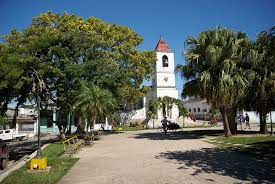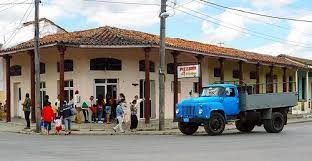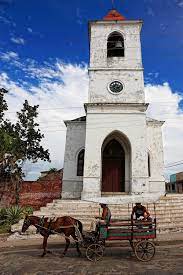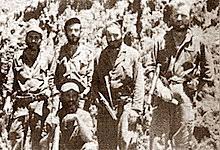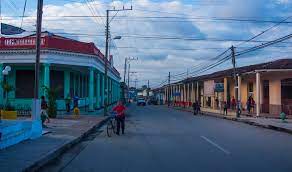MANICARAGUA, PROVINCIA DE VILLA CLARA, CUBA, DONDE SU POBLACIÓN CAMPESINA FUE FORZOSAMENTE LLEVADA A LA PROVINCIA DE PINAR DEL RIO DEBIDO A SUS ACTIVIDADES ANTICASTRISTAS. PHOTOS.
Manicaragua es un municipio y pueblo serrano de la provincia de Villa Clara en Cuba. Está ubicado en la Sierra del Escambray donde fuerzas campesinas anticastristas se rebelaron contra el gobierno comunista central durante varios años, en la parte sur de Villa Clara, limitando con las provincias de Cienfuegos al oeste y Sancti Spíritus al este.
Para evitar que los campesinos de la zona suministraran alimento y ayuda a los “alzados” del Escambray, el Gobierno revolucionario ordenó sacar en masa a los residentes de esas montañas del centro de la Isla. Juan y su familia fueron parte de los deportados que en 1964 fueron llevados hacia los pueblos cautivos, unas comunidades de las que apenas se podía salir o entrar.
Según datos revelados se calcula que en total fueron levantados 21 pueblos de este tipo, rodeados por alambradas y con guardias permanentes a la entrada. Los residentes no podían salir ni recibir visitas, toda la correspondencia era revisada.
Juan Ramos tiene 67 años y no le gusta hablar de su infancia. En el pueblo de Sandino, Pinar del Río, donde toda la familia fue llevada a la fuerza desde las montañas del Escambray.
“Vinimos custodiados todo el viaje por milicianos armados y cuando llegamos aquí mis padres se pusieron muy tristes porque el lugar era feo, bien feo”, en el pueblo de Sandino, Pinar del Río, donde toda la familia fue llevada a la fuerza desde las montañas del Escambray, apunta Juan.
A su alrededor solo se ven edificios de concreto -que parecen jaulas- y albergan a cientos de familias que siguen estando etiquetadas como “conflictivas”.
HISTORIA
El área fue poblada originalmente por los Siboney, un pueblo taíno originario de Cuba. Algunos topónimos de asentamientos incluidos en el municipio (como Manicaragua, Mataguá, Jibacoa, etc.) tienen origen Arawak.
GEOGRAFÍA
El municipio incluye la ciudad propiamente dicha (con alrededor de 23.000 habitantes en 2003) y varios pueblos como Arroyo Seco, El Mango, El Salto del Hanabanilla, Güinía de Miranda, Jibacoa, Jorobada, La Moza, Mataguá (el más poblado), Seibabo, etc. Cuenta con áreas de destacada belleza y valor natural como el Valle de Jibacoa, el Lago Hanabanilla, la Represa y el Hotel del mismo nombre.
DEMOGRAFÍA
En 2004, el municipio de Manicaragua tenía una población de 73,370. [2] Con una superficie total de 1.063 km2 (410 millas cuadradas), [1] tiene una densidad de población de 69,0 / km2 (179 / mi2).
ECONOMÍA
Manicaragua es uno de los cuatro municipios más grandes de Cuba. Los principales cultivos y fuentes de ingresos en esta área incluyen artículos como el tabaco y el café. El café se cultiva en las laderas de las montañas de El Escambray, una cadena montañosa que se extiende desde la parte sureste de la provincia de Cienfuegos hasta la vecina Sancti Spíritus. Los granos de café de Manicaragua producen un néctar sabroso e incomparable, aunque no se conocen en el mundo occidental debido al embargo económico. Al parecer, los puros hechos en la fábrica local gozan de la popularidad de muchos turistas de diferentes partes del mundo. El Hoyo de Manicaragua, una vez conocida como la Tierra del Mejor Tabaco del Mundo, es un pequeño pueblo ubicado en este municipio.
Su popularidad se desvaneció después de que casi toda la población fue reubicada en la occidental provincia cubana de Pinar del Río, un lugar donde muchos de los campesinos locales fueron trasladados debido a sus actividades anticastristas.
Municipios vecinos de Manicaragua:
Cumanayagua 23,2 km Ranchuelo 25 km Desarrollo 26,9 km; Santa Clara 28,5 km Cruces 37,6 km Placetas 37,9 km; Trinidad 38,5 km Lajas 43,9 km Camajuaní 43,9 km; Palmira 44.3 km Cienfuegos 47.5 km.
DISTANCIA ENTRE MANICARAGUA Y LAS PRINCIPALES CIUDADES DEL PAÍS
La Habana: 270 km; Santiago de Cuba: 492 km; Holguín: 410 km; Camagüey: 230 km; Guantánamo: 543 km; Santa Clara: 29 km el más cercano; Bayamo: 398 km; Pinar del Río: 384 km; Las Tunas: 340 km; Cienfuegos: 47 km; Matanzas: 193 km; Ciego de Ávila: 130 km; Sancti Spíritus: 60 km; Manzanillo: 359 km; Palma Soriano: 466 km;
GENTE NOTABLE
Ofelia Domínguez Navarro (1894-1976), escritora, docente, abogada, feminista y activista
Juan Ramón Valdés Gómez (n. 1968), pintor
Código (s) de área + 53-422
MANICARAGUA, PROVINCE OF VILLA CLARA, CUBA, WHERE ITS PEASANT POPULATION WAS FORCIBLY TAKEN TO THE PROVINCE OF PINAR DEL RIO DUE TO ITS ANTI-CASTRO ACTIVITIES. PHOTOS
Manicaragua is a municipality and mountain town in the province of Villa Clara in Cuba. It is located in the Sierra del Escambray where anti-Castro peasant forces rebelled against the central communist government for several years, in the southern part of Villa Clara, bordering the provinces of Cienfuegos to the west and Sancti Spíritus to the east.
To prevent the peasants in the area from supplying food and aid to the “rebels” of the Escambray, the revolutionary government ordered the removal of the residents of these mountains from the center of the island en masse. Juan and his family were among the deportees who in In 1964 they were taken to the captive villages, communities that could hardly be left or entered.
According to revealed data, it is calculated that a total of 21 villages of this type were built, surrounded by barbed wire and with permanent guards at the entrance. Residents could not go out or receive visits, all correspondence was checked.
Juan Ramos is 67 years old and does not like to talk about his childhood. In the town of Sandino, Pinar del Río, where the whole family was forcibly taken from the Escambray mountains.
“We were guarded the entire trip by armed militiamen and when we got here my parents were very sad because the place was ugly, very ugly”, in the town of Sandino, Pinar del Río, where the whole family was taken by force from the Escambray mountains, Juan points out.
Around it, you can only see concrete buildings – which look like cages – and house hundreds of families that are still labeled as “trouble makers.”
HISTORY
The area was originally settled by the Siboney, a Taíno people native of Cuba. Some toponyms of settlements included in the municipality (as Manicaragua, Mataguá, Jibacoa, etc.) have an Arawak origin.
GEOGRAPHY
The municipality includes the town proper (with circa 23,000 inhabitants in 2003) and several villages as Arroyo Seco, El Mango, El Salto del Hanabanilla, Güinía de Miranda, Jibacoa, Jorobada, La Moza, Mataguá (the most populated one), Seibabo etc. It has areas of outstanding natural beauty and value as the Valley of Jibacoa, the Hanabanilla Lake, the dam, and the Hotel of the same name.
DEMOGRAPHICS
In 2004, the municipality of Manicaragua had a population of 73,370.[2] With a total area of 1,063 km2 (410 sq mi),[1] it has a population density of 69.0/km2 (179/sq mi).
ECONOMY
Manicaragua is one of the four largest municipalities in Cuba. Main crops and sources of income in this area include such items as tobacco and coffee. Coffee is grown in the slopes of El Escambray Mountains, a mountain ridge extending from the southeastern part of the Cienfuegos Province to neighboring Sancti Spíritus. Coffee beans from Manicaragua bear flavorous unparallel nectar, though not known in the Western World due to the economic embargo. Not seemingly, cigars made in the local factory, enjoy the popularity of many a tourist from different parts of the World. El Hoyo de Manicaragua, once known as the Land of the Best Tobacco in the World, is a small village located in this municipality.
Its popularity faded after almost the entire population was relocated to the western Cuban province of Pinar del Río, a place where many of the local Campesinos were transferred due to their anti-Castro activities.
Neighboring municipalities of Manicaragua:
Cumanayagua 23.2 km Ranchuelo 25 km Development 26.9 km; Santa Clara 28.5 km Crosses 37.6 km Placetas 37.9 km; Trinidad 38.5 km Lajas 43.9 km Camajuaní 43.9 km; Palmira 44.3 km Cienfuegos 47.5 km.
DISTANCE BETWEEN MANICARAGUA AND THE MAIN CITIES OF THE COUNTRY
Havana: 270 km; Santiago de Cuba: 492 km; Holguín: 410 km; Camagüey: 230 km; Guantánamo: 543 km; Santa Clara: 29 km the closest; Bayamo: 398 km; Pinar del Río: 384 km; Las Tunas: 340 km; Cienfuegos: 47 km; Matanzas: 193 km; Ciego de Ávila: 130 km; Sancti Spíritus: 60 km; Manzanillo: 359 km; Palma Soriano: 466 km;
NOTABLE PEOPLE
Ofelia Domínguez Navarro (1894-1976), writer, teacher, lawyer, feminist and activist
Juan Ramón Valdés Gómez (b. 1968), painter
Area code(s) +53-422
Agencies/ WIki/ ManicaraguaHist/ Extractos/ Excerpts/ Internet Photos/ Arnoldo Varona/ www.TheCubanHistory.com
THE CUBAN HISTORY, HOLLYWOOD.



 MANICARAGUA, Provincia de Villa Clara, Cuba, conocida por la Evacuación forzosa de su población Campesina Anti-Castristas. PHOTOS. * MANICARAGUA, Villa Clara Province, Cuba, known for the forcibly Evacuation of its Anti-Castro Peasant population. PHOTOS.
MANICARAGUA, Provincia de Villa Clara, Cuba, conocida por la Evacuación forzosa de su población Campesina Anti-Castristas. PHOTOS. * MANICARAGUA, Villa Clara Province, Cuba, known for the forcibly Evacuation of its Anti-Castro Peasant population. PHOTOS.